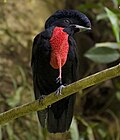Umbrellabird
| Umbrellabirds | |
|---|---|

| |
| Long-wattled umbrellabird (Cephalopterus penduliger) | |
| Scientific classification | |
| Domain: | Eukaryota |
| Kingdom: | Animalia |
| Phylum: | Chordata |
| Class: | Aves |
| Order: | Passeriformes |
| Family: | Cotingidae |
| Genus: | Cephalopterus E. Geoffroy Saint-Hilaire, 1809 |
| Type species | |
| Cephalopterus ornatus[1] E. Geoffroy Saint-Hilaire, 1809
| |
| Species | |
Umbrellabird is the common name referring to three species of birds in the genus Cephalopterus. They are named for their distinct umbrella-like hoods.
The umbrellabird was described by
Basic Information
Umbrellabirds can be found in the rainforests of Central and South America. They are generally solitary, but known to co-inhabit areas with other birds including other umbrellabirds, and similar species such as woodpeckers.[3]
With a total length of 35–50 cm (14–19.5 in), it is among the largest members of the cotinga family, and the male Amazonian umbrellabird is the largest passerine in South America. The typical weight of an umbrellabird ranges from 320 to 570 g (.77 to 1.26 lbs), with a wingspan reaching about 66 to 71 cm (26 to 28 in).[4]
Umbrellabirds are thought to live for an average of 16 years in the wild.[5]
Physiology
The umbrellabird is almost entirely black, and has a conspicuous crest on the top of its head, vaguely resembling an umbrella (hence its
Behavior
The lifestyle of the umbrellabird is
The males gather in loose
Conservation status
Two of the three species, the long-wattled and bare-necked umbrellabirds, are threatened by
Other names
Other common names are bullbird, coracine ombrelle in French, Nacktkehl-Schirmvogel in German, and pájaro paraguas de cuello desnudo in Spanish.
Species
| Image | Scientific name | Common name | Distribution | Conservation status |
|---|---|---|---|---|
 |
Cephalopterus penduliger | Long-wattled umbrellabird | Southwestern part of Colombia to the province of El Oro in Ecuador | Vulnerable |
 |
Cephalopterus ornatus | Amazonian umbrellabird | Amazon basin | Least-concern |
 |
Cephalopterus glabricollis | Bare-necked umbrellabird | Costa Rica and Panama | Endangered |
References
- ^ "Cotingidae". aviansystematics.org. The Trust for Avian Systematics. Retrieved 2023-07-24.
- ^ "Umbrellabird". AZ Animals. Retrieved 2021-10-12.
- ^ "Amazing Facts about Umbrellabirds | OneKindPlanet Animal Education". OneKindPlanet. Retrieved 2021-10-12.
- ^ a b "Best 20 Umbrellabird Facts, Weight, Age, Classification". Retrieved 2021-10-12.
- ^ a b "Long-wattled Umbrellabird - eBird". ebird.org. Retrieved 2021-10-12.
- ^ a b c "The Bizarre Umbrellabird". Not Your Average American. 2019-05-02. Retrieved 2021-10-12.
- .
- ^ a b c "Umbrellabird | bird". Encyclopedia Britannica. Retrieved 2021-10-12.
- ^ a b c d "Umbrellabirds | Beauty of Birds". www.beautyofbirds.com. Retrieved 2021-10-12.
- ^ a b "Long-wattled Umbrellabird". American Bird Conservancy. Retrieved 2021-10-12.
- Fitzpatrick, J. W. (2004). Umbrellabirds (Cephalopterus). Pp. 101–103 in: del Hoyo, J., Elliott, A., & Christie, D. A. eds. (2004). Handbook of the Birds of the World. Vol. 9. Cotingas to Wagtails. Lynx Edicions, Barcelona. ISBN 84-87334-69-5
- "Umbrellabird." (Cephalopterus). Ed. Millie Bond. A-Z Animals, 1 Nov. 2008. Web. 26 Nov. 2015.
Further reading
- ISBN 0-19-858511-X
